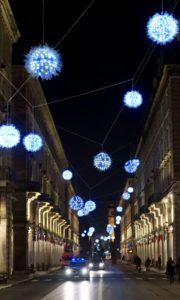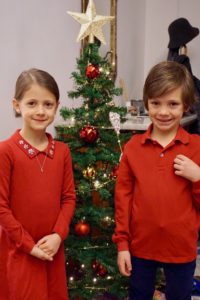Season’s Greetings! This is Josh providing (limited) blogging relief to Jessica, for the first of a couple of holiday-themed posts…
Fact: Italians know how to entertain and enjoy life. Each day is a celebration of food and drink and family. So when one of the biggest holidays of the year rolls around, it should surprise no one that festivities and tradition get turned up to eleven. However, all traditions are local and so while we are mainly adopting holiday customs of the Piemonte region, “fact checkers” may dispute some of my claims.
Christmas, or Natale, is celebrated as a holiday season with a clearly defined beginning and end.

December 8th is the official start to the holiday season. It’s the day that many outdoor decorations are put up in the piazze and streets, Christmas trees are decorated and it’s the opening date for many of the Christmas markets. It’s also a national holiday, known as the Festa dell’Immacolata Concezione (Feast of the Immaculate Conception), a celebration of the conception of the Virgin Mary in the womb of her mother, Saint Anne, and celebrates God’s absolution of Mary’s original sin. It is NOT, though often confused for, a celebration of the conception of Jesus Christ (that would allow for only 17 days of gestation before his birth on Dec 25th which would be an unreasonable expectation, even for the son of God). Personally, I found it a perfectly-timed starting date for the Christmas season.
December 24th is La Vigilia de Natale (Christmas Eve) and is observed with a day-long fast in order to purify bodies for Christmas Day. The traditional custom is to fast through church services in the evening (usually midnight mass) which is then followed by the feast of the seven fishes. Modern custom seems to have relaxed the rules a bit but church services are still a priority, a multi-coursed meal highlighting fish is the focus of the evening and other meats are prohibited. Wine appears to be exempted from all aforementioned rules and its consumption is encouraged.

December 25th is Natale. And on Natale, we eat! The celebration is a day-long feast which starts around lunchtime and continues on through the afternoon with many courses and dishes which center on a multi-coursed, elaborate meal rich in pastas and meats. Champagne complements delicious Italian wines and holiday desserts such as pannetone and pandoro are a plenty. Yes, Santa Claus visits the homes of Italian children (he is referred to as Babo Natale) and presents may be exchanged. But another traditional gift-giving visitor often plays a larger role and is yet to visit…
January 6th is the “twelfth day of Christmas” known as the Epiphany (L’Epiphania). And it’s the morning of the Epiphany when many or most of the gifts are exchanged, thanks to the visit of Befana. Befana is a witch that visits Italian children on a flying broom during the night of January 5th, leaving gifts and candies for well-behaved children (in stockings or shoes) and giving only coal to those behaving poorly during the year (she is also rumored to stand at the end of the bed until morning for the worst offending children…really spooky). Her story tells of a visit by the three wise men and then a shepherd on their way to see the newborn King along with an offer to join them, which she rebuffed. And so her visits are an attempt to right her eternal regret of not accompanying them on the journey. Editor’s note – Italian custom insists that a glass of wine and snacks are left for Befana; cookies and milk is for suckers.
It is the Epiphany that brings a close to Italy’s Christmas season and we are very excited to enjoy all of it!
